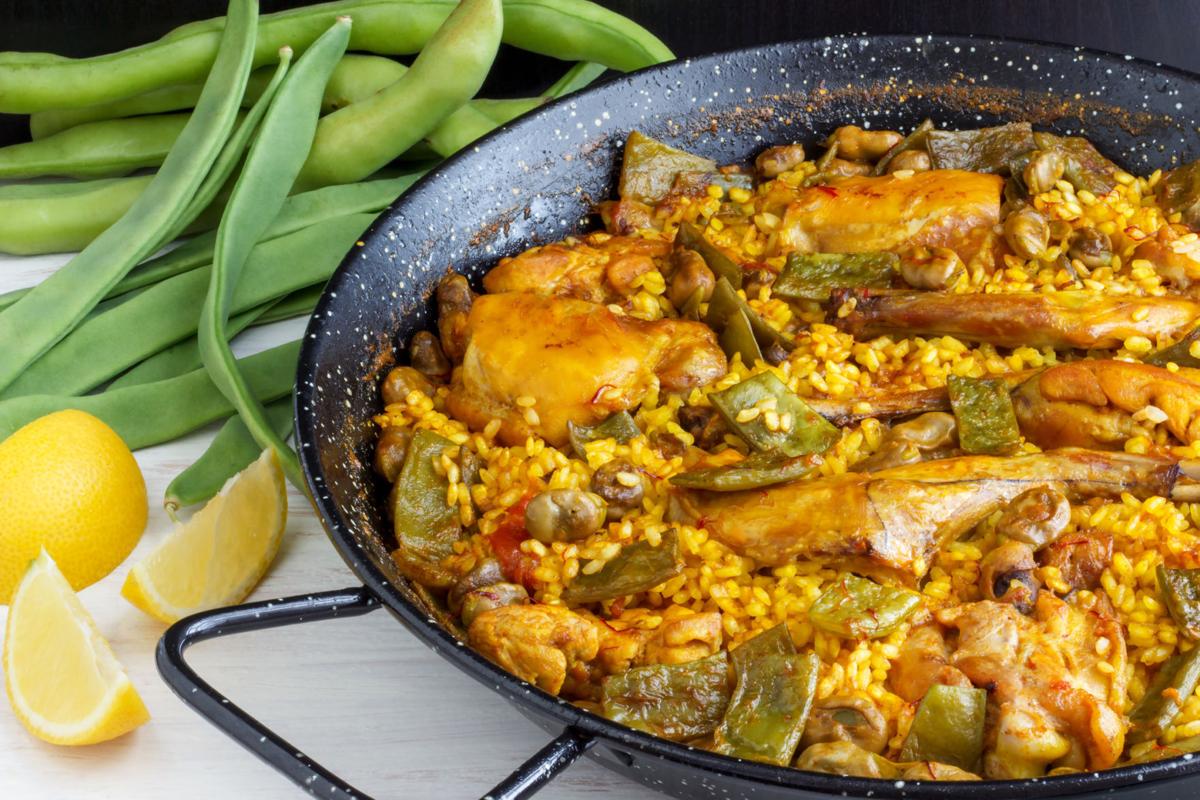My kitchen has been torn up for some minor renovations over the past several weeks, so cooking has been extremely basic. Still, a girl has to eat.
Having lived in the Deep South, I came to love jambalaya, the Creole dish of rice, chicken or pork, and smoked sausage – and sometimes shrimp – which begins with a sauté of the “holy trinity” of chopped bell pepper, celery and onion.
With a limited kitchen in which to function, however, I decided to transform that favorite dish into a paella-style dinner, cooked outside on my charcoal grill. The dishes are so similar that I have to think they have a shared origin.
I like tracing a dish’s lineage, and the common factor I found between the Spanish paella and the Creole jambalaya, with its African origins, is the rice that the Moors apparently introduced wherever they lived. So one could argue that paella and jambalaya are cousins, after a fashion.
Paella is called that because it’s the name of the shallow round pan it’s cooked in. It has its roots in the same Latin word as patella, the shallow dish-like kneecap that covers the joint of hip and shin bones. While we typically think of it as a Spanish dish, I’ve seen it in other places, too.
On a long-ago bicycle trip through Provence, my companion and I came across a group of handsome young Basque guys in a park. They were making a huge paella in a pan more than 4 feet across, cooking over a bed of glowing coals.
It was a fundraiser, one of them explained to me, though he didn’t tell me what it was for, and we were welcome to take part if we wished. We wished, indeed, and for a small price, had a meal that sticks in my memory for its sensual pleasures: smoky overtones from the wood fire, tender bits of chicken and meat, rice imbued with an impossibly flavorful broth. It’s entirely possible that the tariff for our meal went to the Basque Separatist Movement, but even that doesn’t diminish the memory.
Of course, the shallow paella pan I use at home isn’t 4 feet across. It’s actually a 10-inch carbon steel pan with the traditional dimpled bottom — the thought is that liquid collects in the dimples, which came from the pan being hand-hammered, and helps prevent the rice from sticking. It’s just the right size for one or two people. It cost less than $20 and is one of the few specialty cooking pieces I own.
So this week, I hauled it out and made this simple Southwestern paella on my grill. The next time I make it, when my kitchen is restored to its full function, I might use a different cooking vessel, start with the trinity, and call it a jambalaya. Either way, it makes a good, satisfying supper with very little effort.
A SOUTHWESTERN PAELLA
Makes 4 to 6 servings
Paella, like jambalaya and other stewy rice dishes, is accommodating and a great way to use up little bits of leftovers – add cubed leftover roast pork or beef if you have it. Or toss in some frozen shrimp just at the end of cooking time.
INGREDIENTS
1 tablespoon olive oil
1 2½- to 3-pound whole chicken, cut into 6 pieces
1 pound Mexican-style chorizo (see note)
1 head garlic, cloves separated and peeled
Salt to taste
1 teaspoon smoked or mild paprika, or to taste
1 pinch dried thyme, optional
1 pinch dried rosemary, optional
2 teaspoons cumin
4 cups uncooked white rice, or as needed
1 tomato, seeded and finely chopped
1 cup frozen green peas
1 cup frozen green beans
Cilantro, for garnish
Lemon wedges, for serving
PREPARATION
Heat a large shallow pan over medium-high heat, and coat with olive oil. Add the chicken, chorizo, and garlic; cook and stir until nicely browned. Move the browned meat to the sides of the pan. Season with paprika, thyme, rosemary, and cumin and mix well.
Fill the pan almost to the top with water, measuring the water as you put it in. Bring to a boil. Cover and simmer for about 1 hour to make a nice broth.
Season the broth with a generous amount of salt. Stir in half as much rice as the amount of broth in the pan. Stir in tomato, peas, and green beans. Cover, reduce heat to low, and simmer until all of the liquid has been absorbed, about 20 minutes. There’s no need to stir during this simmering; if some of the rice sticks to the bottom of the pan, that’s considered a treat.
Remove the pan from heat and allow to stand for 10 minutes before serving. Sprinkle cilantro leaves over the top, and serve with lemon wedges. Traditionally, paella is eaten from a communal pan, with everyone using their own spoon.
Note: Either bulk or link chorizo can be used here. If bulk, shape the sausage into small balls or patties before cooking; if link, allow to cook through fully before removing, slicing into disks and returning to the pot.





